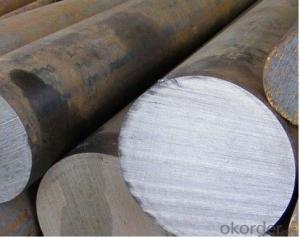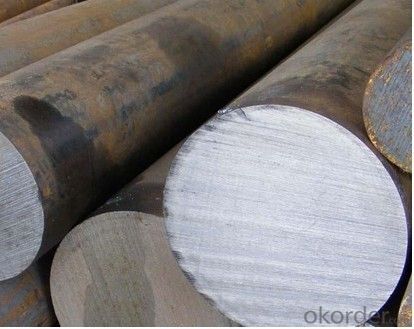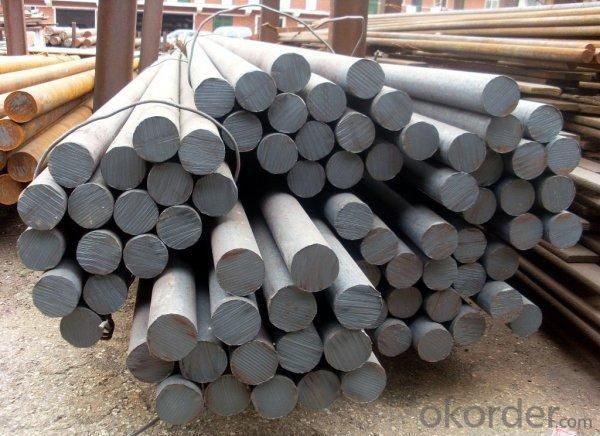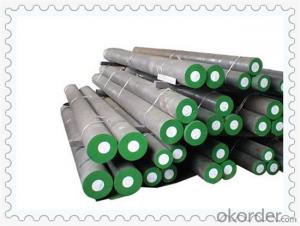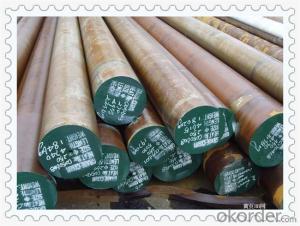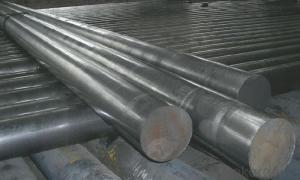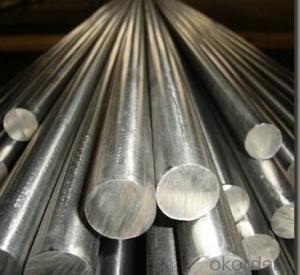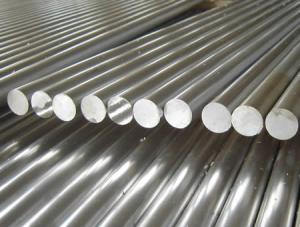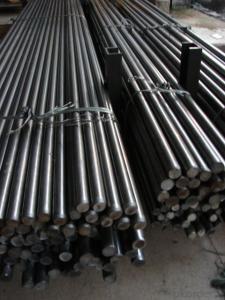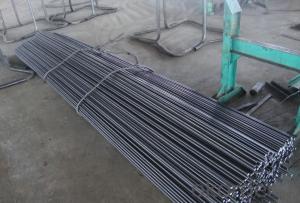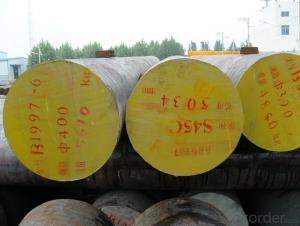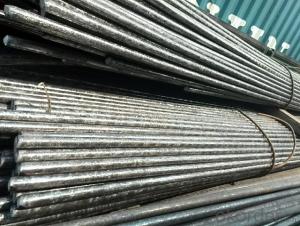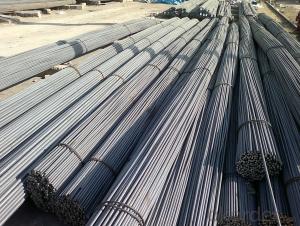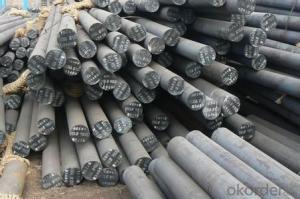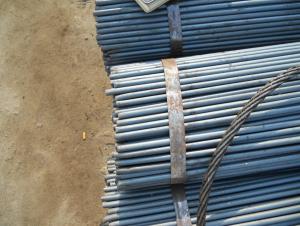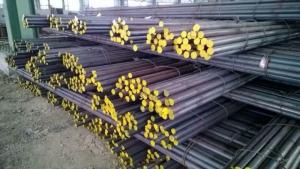Cold Drawn Steel Round Bar with High Quality-100mm-125mm
- Loading Port:
- China Main Port
- Payment Terms:
- TT or LC
- Min Order Qty:
- 100 m.t
- Supply Capability:
- 10000 m.t/month
OKorder Service Pledge
OKorder Financial Service
You Might Also Like
Cold Drawn Steel Round Bar with High Quality-100mm-125mm
Specifications:
1.Size: 100mm-125mm
2.Material: AISI 1045/DIN 1.1191/JIS S45C/GB 45/EN8.
3.Chemical analysis:
C | Si | Mn | P≤ | S≤ | Cr |
0.40~0.60 | 0.20~0.30 | 0.70~0.90 | 0.030 | 0.030 | 0.01~0.03 |
4.Process: EAF + LF + VD + Forged + Heat Treatment (optional)
5.Delivery condition:Hot forged +Rough machined (black surface after Q/T)+ Turned (optional)
6.Technical Data: Chemical Composition, Physical Properties and Mechanical Testing.
7. Test: Ultrasonic test according to SEP 1921-84 3C/c.
8. Standard: GB, AISI, ASTM, DIN, JIS, BS, etc.
9. Quality Management Certification: ISO 9001:2008.
10. Main application:
(1)It is widely used in machinery manufacturing.
(2) For the manufacture of high strength requirements parts, such as gears, shafts, piston pin and the uneven force big machining parts, forgings, stampings and bolts, nuts, pipe joint.
FAQ of Cold Drawn Steel Round Bar with High Quality-100mm-125mm:
Q1: How soon can we receive the product after purchasement?
A1: Within three days of placing an order, we will begin production. The specific shipping date is dependent upon international and government factors, but is typically one month.
Q2: How do you guarantee the quality of our products?
A2: We have established an advanced quality management system which conducts strict quality tests at every step, from raw materials to the final product. At the same time, we provide extensive follow-up service assurances as required.
Q3: The prices are invoicing on theoritical weight or on actual weight?
A3: We can do it in both manners, according to the customers' request.
Images of Cold Drawn Steel Round Bar with High Quality-100mm-125mm:
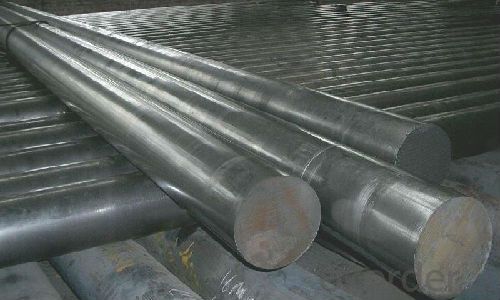
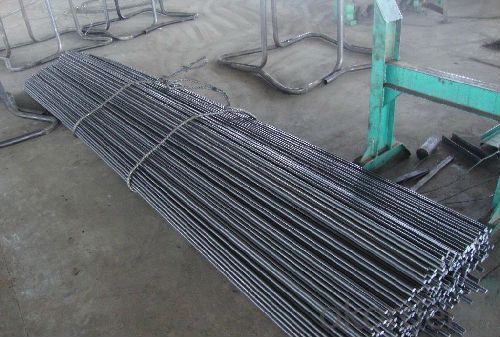
- Q: What are the quality control measures for steel round bars?
- Quality control measures for steel round bars typically involve a series of inspections and tests to ensure that the bars meet the required specifications and standards. These measures are crucial to ensure the structural integrity and reliability of the steel bars. Some common quality control measures for steel round bars include: 1. Visual Inspection: This involves a visual examination of the bars to detect any surface defects such as cracks, pits, or rust. It ensures that the bars have a smooth surface finish and are free from any visible imperfections. 2. Dimensional Inspection: This involves measuring the diameter, length, and straightness of the steel bars to ensure they meet the required tolerances. Any deviations from the specified dimensions can affect the performance and fit of the bars in various applications. 3. Chemical Composition Analysis: Steel round bars undergo chemical composition analysis to verify the percentage of various elements present in the steel. This analysis helps ensure that the bars have the correct alloying elements in the right proportions, which directly impacts their mechanical properties and performance. 4. Mechanical Testing: Various mechanical tests are performed on steel round bars to assess their strength, hardness, and other mechanical properties. These tests can include tensile testing, impact testing, and hardness testing. These tests help determine if the bars meet the required strength and durability standards. 5. Ultrasonic Testing: Ultrasonic testing is often used to detect internal defects such as voids, inclusions, or cracks in steel round bars. This non-destructive testing technique uses high-frequency sound waves to identify any flaws that may compromise the structural integrity of the bars. 6. Surface Treatment Inspection: If the steel round bars undergo any surface treatments such as heat treatment or coating, an inspection is conducted to ensure that the treatments are properly applied and meet the required specifications. 7. Certification and Documentation: Quality control measures also include proper documentation and certification of the steel round bars. This ensures traceability and provides evidence that the bars have undergone the required inspections and tests, giving customers confidence in the product's quality. Overall, these quality control measures for steel round bars help ensure that the bars are of high quality, meet the required specifications, and are suitable for their intended applications.
- Q: What are the different types of steel round bar coatings used in the oil and gas industry?
- There are several types of steel round bar coatings commonly used in the oil and gas industry. Some of these coatings include fusion bonded epoxy (FBE), three-layer polyethylene (3LPE), three-layer polypropylene (3LPP), and metallic zinc coatings. These coatings are applied to steel round bars to provide corrosion resistance, enhance durability, and protect against harsh environmental conditions in oil and gas applications.
- Q: How do you prevent steel round bars from rusting?
- To prevent steel round bars from rusting, several measures can be taken. One effective method is to apply a protective coating or paint to the surface of the bars, which acts as a barrier against moisture and oxygen. Additionally, regular cleaning and maintenance to remove any dirt, debris, or corrosive substances can help prevent rust formation. Storing the bars in a dry and controlled environment, away from humidity and moisture, is also crucial. Moreover, using galvanized steel round bars, which have a zinc coating, or stainless steel bars that are resistant to corrosion, can provide long-term rust prevention.
- Q: How are steel round bars used in the construction of high-rise buildings?
- Due to their strength, durability, and versatility, steel round bars are commonly utilized in the construction of high-rise buildings. Carbon steel is typically used to manufacture these bars because it possesses excellent mechanical properties and can endure high loads and pressures. In reinforced concrete structures for high-rise buildings, steel round bars are primarily employed. They serve as reinforcement in concrete beams, columns, and slabs. By embedding the bars in the concrete, the overall structure gains added strength and stiffness. One of the main benefits of utilizing steel round bars is their ability to withstand tension forces. Concrete is strong in compression but weak in tension. Therefore, the steel bars act as tension reinforcement, preventing the concrete from cracking or failing when subjected to tension loads. This significantly improves the building's structural integrity and overall safety. Moreover, steel round bars offer easy bending, shaping, and welding, allowing for flexible design and construction options. They can be customized to specific lengths and diameters to meet the requirements of the building project. This adaptability makes them ideal for constructing various structural elements, like beams and columns, which must be precisely engineered to support the weight and stresses of a high-rise building. Furthermore, steel round bars exhibit excellent resistance to corrosion, which proves crucial when constructing high-rise buildings exposed to various environmental elements. The steel's corrosion-resistant properties ensure the structure's long-term durability and lifespan. In conclusion, steel round bars are essential in the construction of high-rise buildings as they provide strength, durability, and flexibility to reinforced concrete structures. They enhance the overall structural integrity, safety, and longevity of the building, making them a crucial component in modern construction practices.
- Q: How do you know the diameter and weight of a round bar?
- The weight divided by the length is the bottom area of 2, Wu R - is the bottom area. The diameter is equal to 2R
- Q: Can steel round bars be used in the manufacturing of couplings?
- Yes, steel round bars can be used in the manufacturing of couplings. Steel round bars are commonly used in various industrial applications due to their strength, durability, and versatility. Couplings are mechanical devices that connect two shafts together in order to transmit power or allow for the misalignment of the shafts. Steel round bars can be machined, formed, or welded to create different types of couplings, such as rigid couplings, flexible couplings, or universal couplings. The use of steel round bars in manufacturing couplings ensures that the couplings have high tensile strength and can withstand heavy loads and torque. Additionally, steel round bars can be heat-treated to enhance their mechanical properties, making them suitable for different operating conditions and environments. Therefore, steel round bars are a popular choice for the manufacturing of couplings.
- Q: Can steel round bars be bent or formed?
- Steel round bars have the capability to be bent or formed, depending on several factors such as the type of steel, bar diameter and thickness, and the chosen bending or forming method. There are various techniques available for bending or forming steel round bars, including hot bending, cold bending, and mechanical bending. In hot bending, the steel round bar is heated to a specific temperature and then shaped according to the desired form. On the other hand, cold bending does not require any heating and can be accomplished using hydraulic or manual bending machines. Mechanical bending, however, involves the utilization of specialized machinery to apply force and bend the steel round bar. It is vital to note that excessive bending or forming may weaken the steel round bar and affect its structural integrity. Hence, it is crucial to adhere to proper bending and forming techniques and consider the manufacturer's limitations and industry standards.
- Q: What is the difference between a cold finished and a turned steel round bar?
- Cold finished steel round bars and turned steel round bars are utilized in various industries for different purposes. The manufacturing process and resulting properties distinguish these two types of steel bars. For a cold finished steel round bar, the production involves cold drawing or cold rolling a hot rolled steel bar. This entails passing the hot rolled bar through a series of dies at room temperature, which decreases its diameter and increases its length. Through the cold drawing process, the steel acquires specific mechanical properties, including enhanced surface finish, dimensional accuracy, and increased strength. Cold finished steel bars possess a sleek, glossy surface and are renowned for their precise tolerances and consistent size and shape. They find common usage in applications requiring precision and high-quality surface finish, such as the automotive, aerospace, and machining industries. Conversely, a turned steel round bar is created by machining a hot rolled or cold finished bar on a lathe. The bar is secured and rotated while a cutting tool eliminates material from its outer surface, resulting in the desired shape and dimensions. This turning process yields a bar with a rougher surface compared to a cold finished bar. However, it enables faster production and versatility in creating diverse shapes and sizes. Turned steel bars are frequently employed in applications where the surface finish is not crucial but machining operations are necessary, such as in the construction, engineering, and manufacturing industries. In conclusion, the distinction between a cold finished and a turned steel round bar lies in the manufacturing process and the resulting properties. Cold finished bars are produced through cold drawing or cold rolling, leading to improved dimensional accuracy, surface finish, and strength. Turned bars are machined on a lathe, providing flexibility in shape and size but with a rougher surface finish. The choice between the two depends on the specific requirements of the application, including tolerance, surface finish, strength, and machinability.
- Q: How are steel round bars measured and specified?
- Steel round bars are measured and specified based on their diameter. The diameter of a round bar is typically measured in millimeters (mm) or inches (in). The measurement is taken across the widest point of the circular cross-section. In terms of specification, steel round bars are commonly specified by their diameter and length. For example, a specification for a steel round bar may be written as "25mm diameter x 3 meters length". This means that the bar has a diameter of 25mm and a length of 3 meters. Additionally, steel round bars may also be specified based on their tolerance, surface finish, and grade. Tolerance refers to the allowable deviation from the specified diameter. Surface finish refers to the quality of the bar's surface, which can range from rough to smooth. Grade refers to the quality and composition of the steel used to make the round bar, such as mild steel, carbon steel, or alloy steel. It is important to accurately measure and specify steel round bars to ensure that they meet the required dimensions and properties for a particular application.
- Q: Can steel round bars be used in the production of springs?
- Yes, steel round bars can be used in the production of springs. Steel is a common material used in the manufacturing of springs due to its high strength and durability. Steel round bars are often used to create the base material for springs, as they can be easily shaped and formed into the desired spring shape. Additionally, steel round bars can be heat-treated to enhance their mechanical properties, making them suitable for various spring applications. The specific type of steel used will depend on the desired characteristics and requirements of the spring, such as the desired level of flexibility and resistance to deformation. Overall, steel round bars are widely utilized in the production of springs due to their excellent mechanical properties, making them a suitable choice for many spring applications.
Send your message to us
Cold Drawn Steel Round Bar with High Quality-100mm-125mm
- Loading Port:
- China Main Port
- Payment Terms:
- TT or LC
- Min Order Qty:
- 100 m.t
- Supply Capability:
- 10000 m.t/month
OKorder Service Pledge
OKorder Financial Service
Similar products
Hot products
Hot Searches
Related keywords
